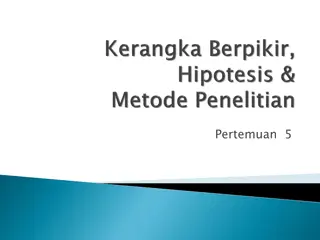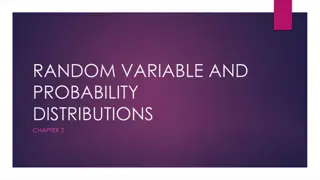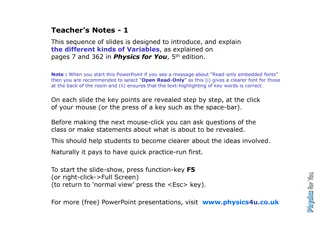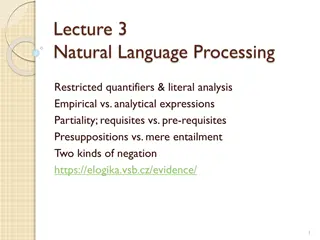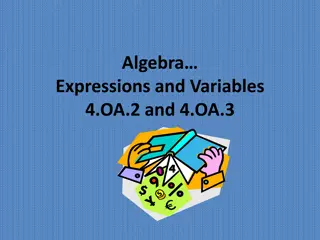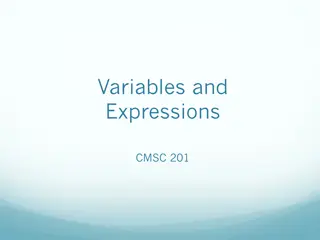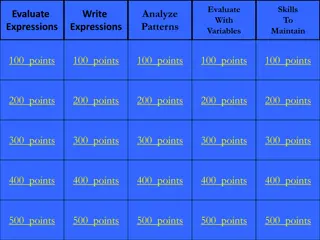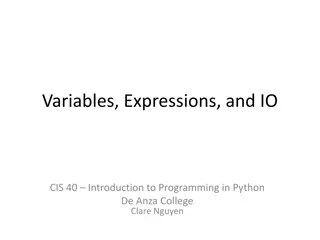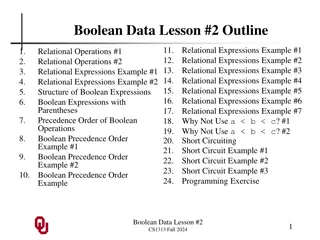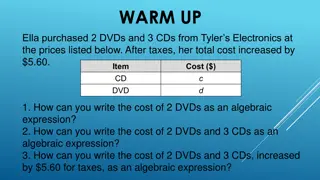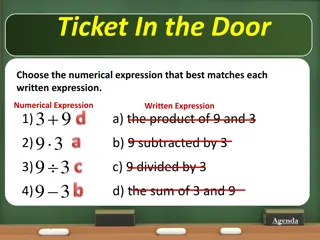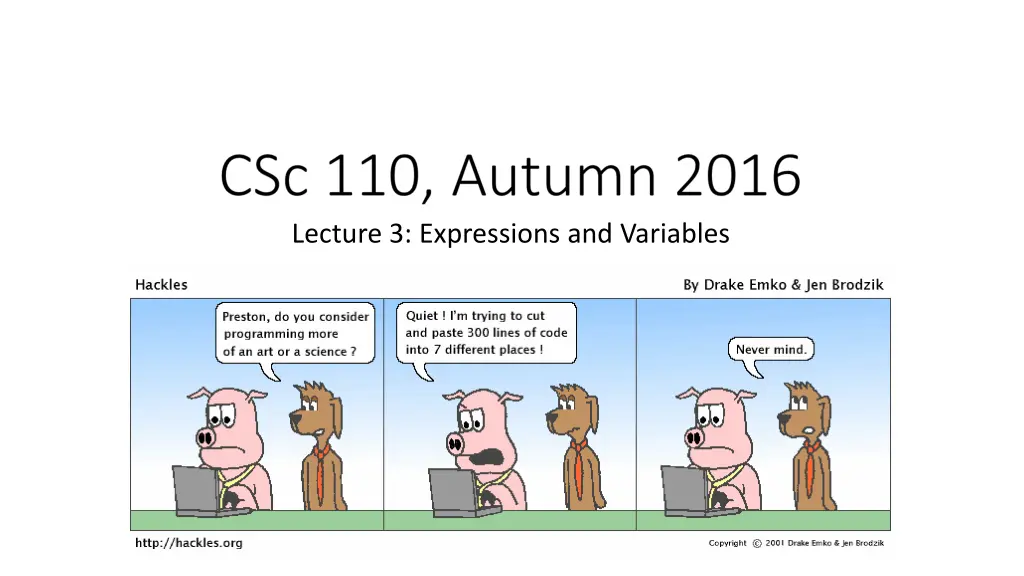
Understanding Expressions, Variables, and Data Types in Python
Learn about expressions, variables, data types, and arithmetic operators in Python. Discover how Python handles integer division, integer remainder, and operator precedence. Explore practical applications of these concepts in programming.
Download Presentation

Please find below an Image/Link to download the presentation.
The content on the website is provided AS IS for your information and personal use only. It may not be sold, licensed, or shared on other websites without obtaining consent from the author. If you encounter any issues during the download, it is possible that the publisher has removed the file from their server.
You are allowed to download the files provided on this website for personal or commercial use, subject to the condition that they are used lawfully. All files are the property of their respective owners.
The content on the website is provided AS IS for your information and personal use only. It may not be sold, licensed, or shared on other websites without obtaining consent from the author.
E N D
Presentation Transcript
Data types Internally, computers store everything as 1s and 0s 104 01101000 'hi' 0110100001101001 'h' 01101000 How are h and 104 differentiated? type: A category or set of data values. Constrains the operations that can be performed on data Many languages ask the programmer to specify types Examples: integer, real number, string
Python's number types Name Description Examples int 42, -3, 0, 926394 integers (up to 231- 1) float 3.1, -0.25 real numbers complex
Expressions expression: A value or operation that computes a value. 1 + 4 * 5 (7 + 2) * 6 / 3 42 Examples: The simplest expression is a literal value. A complex expression can use operators and parentheses.
Arithmetic operators operator: Combines multiple values or expressions. + addition - subtraction (or negation) * multiplication / division // integer division (a.k.a. leave off any remainder) % modulus (a.k.a. remainder) ** exponent As a program runs, its expressions are evaluated. 1 + 1 evaluates to 2
Integer division with // When we divide integers with //, the quotient is also an integer. 14 // 4 is 3, not 3.5 3 4 52 4 ) 14 10 ) 45 27 ) 1425 12 40 2 5 75 135 54 21 More examples: 32 // 5 84 // 10 156 // 100 is 1 is 6 is 8 Dividing by 0 causes an error when your program runs.
Integer remainder with % The % operator computes the remainder from integer division. 14 % 4 is 2 218 % 5 is 3 3 4 ) 14 5 ) 218 12 2 What is the result? 45 % 6 2 % 2 8 % 20 11 % 0 43 20 18 15 3 Applications of % operator: Obtain last digit of a number: Obtain last 4 digits: See whether a number is odd: 230857 % 10 is 7 658236489 % 10000 is 6489 7 % 2 is 1, 42 % 2 is 0
Precedence precedence: Order in which operators are evaluated. Generally operators evaluate left-to-right. 1 - 2 - 3 is (1 - 2) - 3 which is -4 But */ // % have a higher level of precedence than +- 1 + 3 * 4 is 13 6 + 8 // 2 * 3 6 + 4 * 3 6 + 12 is 18 Parentheses can force a certain order of evaluation: (1 + 3) * 4 is 16 Spacing does not affect order of evaluation 1+3 * 4-2 is 11
Precedence examples 1 * 2.0 + 3 * 5 % 4 \_/ | 2.0 + 3 * 5 % 4 \_/ | 2.0 + 15 % 4 \___/ | 2.0 + 3 \________/ | 5.0 1 + 8 % 3 * 2 - 9 \_/ | 1 + 2 * 2 - 9 \___/ | 1 + 4 - 9 \______/ | 5 - 9 \_________/ | -4
Precedence questions What values result from the following expressions? 9 // 5 695 % 20 7 + 6 * 5 7 * 6 + 5 248 % 100 / 5 6 * 3 - 9 // 4 (5 - 7) * 2 ** 2 6 + (18 % (17 - 12))
Receipt example What's bad about the following code? # Calculate total owed, assuming 8% tax / 15% tip print("Subtotal:") print(38 + 40 + 30) print("Tax:") print((38 + 40 + 30) * .08) print("Tip:") print((38 + 40 + 30) * .15) print("Total:") print(38 + 40 + 30 + (38 + 40 + 30) * .15 + (38 + 40 + 30) * .08) The subtotal expression (38 + 40 + 30) is repeated So many print statements
Variables variable: A piece of the computer's memory that is given a name and type, and can store a value. Like preset stations on a car stereo, or cell phone speed dial: Steps for using a variable: Declare/initialize it Use it - state its name and type and store a value into it - print it or use it as part of an expression
Declaration and assignment variable declaration and assignment: Sets aside memory for storing a value and stores a value into a variable. Variables must be declaredbefore they can be used. The value can be an expression; the variable stores its result. Syntax: name = expression zipcode 90210 zipcode = 90210 myGPA = 1.0 + 2.25 myGPA 3.25
Using variables Once given a value, a variable can be used in expressions: x = 3 # x is 3 y = 5 * x - 1 # now y is 14 You can assign a value more than once: x x 3 11 x = 3 # 3 here x = 4 + 7 # now x is 11
Assignment and algebra Assignment uses = , but it is not an algebraic equation. = means, "store the value at right in variable at left" The right side expression is evaluated first, and then its result is stored in the variable at left. What happens here? x x 3 5 x = 3 x = x + 2 # ???
Receipt question Improve the receipt program using variables. def main(): # Calculate total owed, assuming 8% tax / 15% tip print("Subtotal:") print(38 + 40 + 30) print("Tax:") print((38 + 40 + 30) * .08) print("Tip:") print((38 + 40 + 30) * .15) print("Total:") print(38 + 40 + 30 + (38 + 40 + 30) * .15 + (38 + 40 + 30) * .08)
Printing a variable's value Use + str(value) to print a string and a variable's value on one line. grade = (95.1 + 71.9 + 82.6) / 3.0 print("Your grade was " + str(grade)) students = 11 + 17 + 4 + 19 + 14 print("There are " + str(students) + " students in the course.") Output: Your grade was 83.2 There are 65 students in the course.
Receipt answer def main(): # Calculate total owed, assuming 8% tax / 15% tip subtotal = 38 + 40 + 30 # int tax = subtotal * .08 # float tip = subtotal * .15 # float total = subtotal + tax + tip # float print("Subtotal: " + str(subtotal)) print("Tax: " + str(tax)) print("Tip: " + str(tip)) print("Total: " + str(total))

